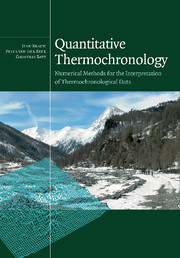Book contents
- Frontmatter
- Contents
- Preface
- 1 Introduction
- 2 Basics of thermochronology: from t–T paths to ages
- 3 Thermochronological systems
- 4 The general heat-transport equation
- 5 Thermal effects of exhumation
- 6 Steady-state two-dimensional heat transport
- 7 General transient solution – the three-dimensional problem
- 8 Inverse methods
- 9 Detrital thermochronology
- 10 Lateral advection of material
- 11 Isostatic response to denudation
- 12 The evolution of passive-margin escarpments
- 13 Thermochronology in active tectonic settings
- Appendix 1 Forward models of fission-track annealing
- Appendix 2 Fortran routines provided with this textbook
- Appendix 3 One-dimensional conductive equilibrium with heat production
- Appendix 4 One-dimensional conductive equilibrium with anomalous conductivity
- Appendix 5 One-dimensional transient conductive heat transport
- Appendix 6 Volume integrals in spherical coordinates
- Appendix 7 The complementary error function
- Appendix 8 Pecube user guide
- Appendix 9 Tutorial solutions
- References
- Index
4 - The general heat-transport equation
Published online by Cambridge University Press: 15 December 2009
- Frontmatter
- Contents
- Preface
- 1 Introduction
- 2 Basics of thermochronology: from t–T paths to ages
- 3 Thermochronological systems
- 4 The general heat-transport equation
- 5 Thermal effects of exhumation
- 6 Steady-state two-dimensional heat transport
- 7 General transient solution – the three-dimensional problem
- 8 Inverse methods
- 9 Detrital thermochronology
- 10 Lateral advection of material
- 11 Isostatic response to denudation
- 12 The evolution of passive-margin escarpments
- 13 Thermochronology in active tectonic settings
- Appendix 1 Forward models of fission-track annealing
- Appendix 2 Fortran routines provided with this textbook
- Appendix 3 One-dimensional conductive equilibrium with heat production
- Appendix 4 One-dimensional conductive equilibrium with anomalous conductivity
- Appendix 5 One-dimensional transient conductive heat transport
- Appendix 6 Volume integrals in spherical coordinates
- Appendix 7 The complementary error function
- Appendix 8 Pecube user guide
- Appendix 9 Tutorial solutions
- References
- Index
Summary
In this chapter, we derive the differential equation governing the transport of heat in solids. This equation is used to estimate the contributions from conduction, tectonic advection and radiogenic heat production in geological systems. We discuss the various types of boundary conditions that are applicable in the context of tectonic and geomorphic problems. We then provide the solution of the heat-transport equation under the assumption of one-dimensionality and neglecting the effect of rock advection towards the cold surface. In doing so we provide a reference conductive solution under a range of assumptions concerning the conductivity and the rate of heat production in the crust.
Heat transport within the Earth
In solids, heat is principally transported by conduction or advection. Conduction implies a transfer of molecular vibrational energy; advection implies a spatial reorganisation of the internal heat of the system by the relative translation of some of its parts.
Within the Earth, heat is constantly being produced by the natural radioactive decay of unstable isotopes, principally uranium, potassium and thorium. The heat is produced at such a rate and over such a large volume (the entire crust and mantle) that, if it were transported out of the system by conduction only, the entire planet would rapidly reach melting temperature. In fact, the transport is mostly by advection: most of the Earth's mantle is at such a temperature that it is sufficiently weak to flow over geological timescales.
- Type
- Chapter
- Information
- Quantitative ThermochronologyNumerical Methods for the Interpretation of Thermochronological Data, pp. 60 - 75Publisher: Cambridge University PressPrint publication year: 2006



